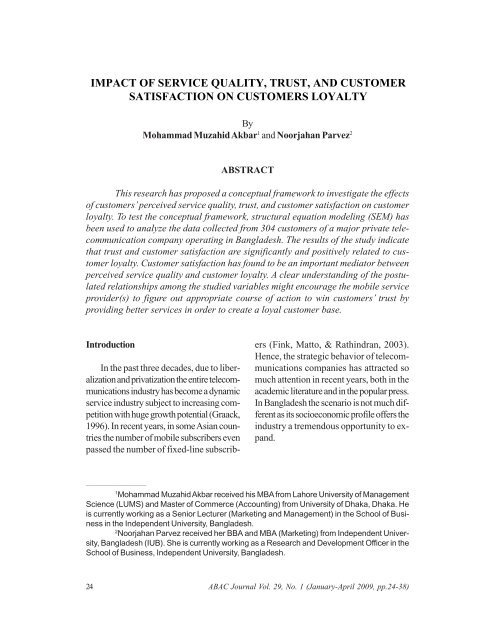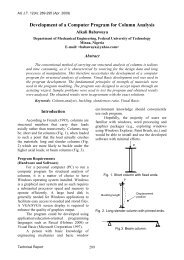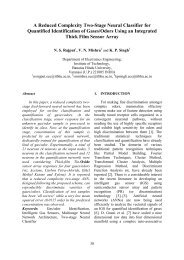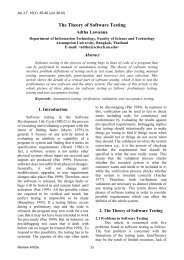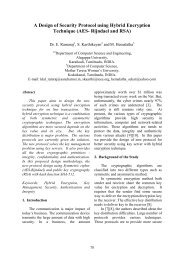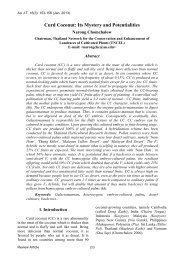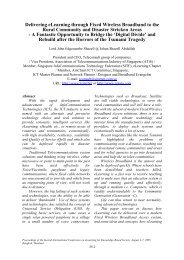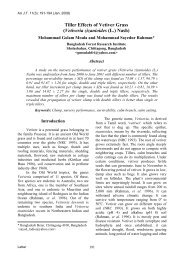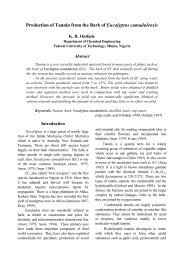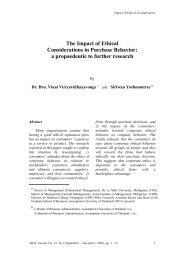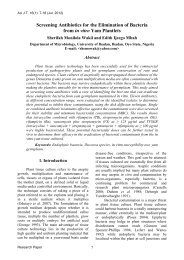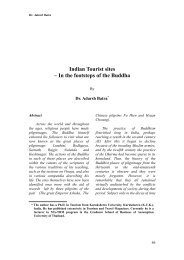Impact of Service Quality, Trust, and Customer ... - AU Journal
Impact of Service Quality, Trust, and Customer ... - AU Journal
Impact of Service Quality, Trust, and Customer ... - AU Journal
You also want an ePaper? Increase the reach of your titles
YUMPU automatically turns print PDFs into web optimized ePapers that Google loves.
CAN SERVICE QUALITY, TRUST, AND CUSTOMER<br />
SATISFACTION ENGENDER CUSTOMERS LOYALTY?<br />
By<br />
Mohammad Muzahid Akbar 1 <strong>and</strong> Noorjahan Parvez 2<br />
ABSTRACT<br />
This research has proposed a conceptual framework to investigate the effects<br />
<strong>of</strong> customers’ perceived service quality, trust, <strong>and</strong> customer satisfaction on customer<br />
loyalty. To test the conceptual framework, structural equation modeling (SEM) has<br />
been used to analyze the data collected from 304 customers <strong>of</strong> a major private telecommunication<br />
company operating in Bangladesh. The results <strong>of</strong> the study indicate<br />
that trust <strong>and</strong> customer satisfaction are significantly <strong>and</strong> positively related to customer<br />
loyalty. <strong>Customer</strong> satisfaction has found to be an important mediator between<br />
perceived service quality <strong>and</strong> customer loyalty. A clear underst<strong>and</strong>ing <strong>of</strong> the postulated<br />
relationships among the studied variables might encourage the mobile service<br />
provider(s) to figure out appropriate course <strong>of</strong> action to win customers’ trust by<br />
providing better services in order to create a loyal customer base.<br />
Introduction<br />
In the past three decades, due to liberalization<br />
<strong>and</strong> privatization the entire telecommunications<br />
industry has become a dynamic<br />
service industry subject to increasing competition<br />
with huge growth potential (Graack,<br />
1996). In recent years, in some Asian countries<br />
the number <strong>of</strong> mobile subscribers even<br />
passed the number <strong>of</strong> fixed-line subscrib-<br />
_________________________<br />
ers (Fink, Matto, & Rathindran, 2003).<br />
Hence, the strategic behavior <strong>of</strong> telecommunications<br />
companies has attracted so<br />
much attention in recent years, both in the<br />
academic literature <strong>and</strong> in the popular press.<br />
In Bangladesh the scenario is not much different<br />
as its socioeconomic pr<strong>of</strong>ile <strong>of</strong>fers the<br />
industry a tremendous opportunity to exp<strong>and</strong>.<br />
1 Mohammad Muzahid Akbar received his MBA from Lahore University <strong>of</strong> Management<br />
Science (LUMS) <strong>and</strong> Master <strong>of</strong> Commerce (Accounting) from University <strong>of</strong> Dhaka, Dhaka. He<br />
is currently working as a Senior Lecturer (Marketing <strong>and</strong> Management) in the School <strong>of</strong> Business<br />
in the Independent University, Bangladesh.<br />
2 Noorjahan Parvez received her BBA <strong>and</strong> MBA (Marketing) from Independent University,<br />
Bangladesh (IUB). She is currently working as a Research <strong>and</strong> Development Officer in the<br />
School <strong>of</strong> Business, Independent University, Bangladesh.<br />
24 ABAC <strong>Journal</strong> Vol. 29, No. 1 (January-April 2009, pp.24-38)
Can <strong>Service</strong> <strong>Quality</strong>, <strong>Trust</strong>, <strong>and</strong> <strong>Customer</strong> Satisfaction Engender <strong>Customer</strong>s Loyalty?<br />
Currently the number <strong>of</strong> telecommunications<br />
companies operating Bangladesh is<br />
six (five private <strong>and</strong> one state-owned); but<br />
the aggressive competition has forced the<br />
incumbent telecommunications companies or<br />
mobile operators to reconfigure their strategy<br />
<strong>and</strong> business to sustain or improve their<br />
competitive advantage.<br />
In this emerging market customers are<br />
not that loyal to one particular private<br />
telecommunication company. Hence, the<br />
major private telecommunication companies<br />
forced to consider how to create a<br />
loyal customer base that will not be<br />
eroded even in the face <strong>of</strong> fierce competition.<br />
Therefore, the these telecommunication<br />
companies must realize the necessity<br />
<strong>of</strong> studying <strong>and</strong> underst<strong>and</strong>ing<br />
various antecedents (viz. service quality,<br />
switching cost, trust, corporate image,<br />
<strong>and</strong> customer satisfaction) <strong>of</strong> the customer<br />
loyalty which might help them to<br />
develop a loyal customer base (Sharp &<br />
Sharp, 1997).<br />
As reported in the relevant literature<br />
high quality service helps to generate<br />
customer satisfaction, customer loyalty,<br />
<strong>and</strong> growth <strong>of</strong> market share by soliciting<br />
new customers, <strong>and</strong> improved productivity<br />
<strong>and</strong> financial performance (Lewis,<br />
1993; Andereson, Fornell, & Lehmann,<br />
1994). Hackl, Scharitzer, <strong>and</strong> Zuba<br />
(2000) had substantiated the point by<br />
adding that customer satisfaction is a prerequisite<br />
<strong>of</strong> customer retention <strong>and</strong> loyalty.<br />
Corbitt, Thanasankit, <strong>and</strong> Yi (2003)<br />
have investigated the effect <strong>of</strong> trust on<br />
customer loyalty in telecommunication<br />
sector <strong>and</strong> found trust has a strong effect<br />
on customer loyalty.<br />
The objective <strong>of</strong> this study is to analyze<br />
a conceptual framework empirically that<br />
considers the interrelationships <strong>of</strong> customers’<br />
perceived service quality, trust, <strong>and</strong> customer<br />
satisfaction <strong>and</strong> customer loyalty in<br />
the context <strong>of</strong> a group <strong>of</strong> customers <strong>of</strong> a<br />
major private telecommunication company<br />
in Bangladesh.<br />
Review <strong>of</strong> Literature<br />
<strong>Service</strong> <strong>Quality</strong><br />
Traditionally, service quality has been<br />
conceptualized as the difference between<br />
customer expectations regarding a service<br />
to be received <strong>and</strong> perceptions <strong>of</strong> the<br />
service being received (Grönroos, 2001;<br />
Parasuraman, Zeithaml, & Berry, 1988).<br />
In some earlier studies, service quality<br />
has been referred as the extent to which<br />
a service meets customers’ needs or expectations<br />
(Lewis & Mitchell, 1990;<br />
Dotchin & Oakl<strong>and</strong>, 1994). It is also conceptualized<br />
as the consumer’s overall<br />
impression <strong>of</strong> the relative inferiority or<br />
superiority <strong>of</strong> the services (Zeithaml,<br />
Berry, & Parasuraman, 1990).<br />
<strong>Service</strong> <strong>Quality</strong> Dimensions<br />
Parasuraman et al. (1988) identified five<br />
dimensions <strong>of</strong> service quality (viz. reliability,<br />
responsiveness, assurance, empathy, <strong>and</strong><br />
tangibles) that link specific service characteristics<br />
to consumers’ expectations.<br />
(a) Tangibles - physical facilities, equipment<br />
<strong>and</strong> appearance <strong>of</strong> personnel;<br />
(b) Empathy - caring, individualized<br />
attention;<br />
(c) Assurance - knowledge <strong>and</strong> cour-<br />
25
Mohammad Muzahid Akbar <strong>and</strong> Noorjahan Parvez<br />
tesy <strong>of</strong> employees <strong>and</strong> their ability to convey<br />
trust <strong>and</strong> confidence;<br />
(d) Reliability - ability to perform the<br />
promised service dependably <strong>and</strong> accurately;<br />
<strong>and</strong><br />
(e) Responsiveness - willingness to<br />
help customers <strong>and</strong> provide prompt service.<br />
After a comprehensive review <strong>of</strong> service<br />
quality studies, Asubonteng,<br />
McCleary, <strong>and</strong> Swan (1996) concluded<br />
that the number <strong>of</strong> service quality dimensions<br />
varies in different industries. For<br />
example, Kettinger <strong>and</strong> Lee (1994) identified<br />
four dimensions in a study <strong>of</strong> information<br />
systems (IS) quality, which did<br />
not have tangible dimension. Cronin <strong>and</strong><br />
Taylor (1992) developed a one-factor<br />
measurement instrument instead <strong>of</strong> the<br />
five-factor measures proposed by<br />
Parasuraman et al. (1988).<br />
Besides SERVQUAL, Sureshch<strong>and</strong>ar,<br />
Rajendran, <strong>and</strong> Anantharaman<br />
(2003) have identified five factors <strong>of</strong> service<br />
quality from the customers’ perspective.<br />
Those are: a) Core service or service<br />
product, b) Human element <strong>of</strong> service<br />
delivery, c) Systematization <strong>of</strong> service<br />
delivery: non- human element, d)<br />
Tangibles <strong>of</strong> service, <strong>and</strong> e) Social responsibility.<br />
After a close inspection it<br />
could be safely concluded that the newly<br />
defined construct <strong>of</strong> service quality by<br />
Sureshch<strong>and</strong>ar et al. (2003) has some<br />
resemblance with the definition provided<br />
by Parasuraman et al. (1988). For this<br />
study the researchers have employed the<br />
five dimensions <strong>of</strong> service quality proposed<br />
by Parasuraman et al. (1988).<br />
26<br />
<strong>Trust</strong><br />
In business trust is viewed as one <strong>of</strong> the<br />
most relevant antecedents <strong>of</strong> stable <strong>and</strong><br />
collaborative relationships. Researchers had<br />
established that trust is essential for building<br />
<strong>and</strong> maintaining long-term relationships<br />
(Rousseau, Sitkin, Burt, & Camerer, 1998;<br />
Singh & Sirdeshmukh, 2000). Morgan <strong>and</strong><br />
Hunt (1994) stated that trust exists only<br />
when one party has confidence in an exchange<br />
partner’s reliability <strong>and</strong> integrity.<br />
While defining trust Moorman, Deshp<strong>and</strong>e,<br />
<strong>and</strong> Zaltman (1993) referred to the willingness<br />
to rely on an exchange partner in whom<br />
one has confidence. According to Lau <strong>and</strong><br />
Lee (1999), if one party trusts another party<br />
that eventually engenders positive behavioral<br />
intentions towards the second party.<br />
From Anderson <strong>and</strong> Narus (1990) it can<br />
be safely deduced that if one party believes<br />
that the actions <strong>of</strong> the other party will bring<br />
positive outcomes to the first party, trust can<br />
be developed. Doney <strong>and</strong> Cannon (1997)<br />
added that the concerned party also must<br />
have the ability to continue to meet its obligations<br />
towards its customers within the<br />
cost-benefits relationship; so, the customer<br />
should not only foresee the positive outcomes<br />
but also believe that these positive<br />
outcomes will continue in the future. The<br />
definition provided by Morgan <strong>and</strong> Hunt<br />
(1994) has been used for this study.<br />
<strong>Customer</strong> Satisfaction<br />
<strong>Customer</strong> satisfaction is a well known<br />
<strong>and</strong> established concept in several areas like<br />
marketing, consumer research, economic<br />
psychology, welfare-economics, <strong>and</strong> economics.
The most common interpretations obtained<br />
from various authors reflect the notion<br />
that satisfaction is a feeling which results<br />
from a process <strong>of</strong> evaluating what has<br />
been received against what was expected,<br />
including the purchase decision itself <strong>and</strong> the<br />
needs <strong>and</strong> wants associated with the purchase<br />
(Armstrong & Kotler, 1996). Bitner<br />
& Zeithaml (2003) stated that satisfaction<br />
is the customers’ evaluation <strong>of</strong> a product or<br />
service in terms <strong>of</strong> whether that product or<br />
service has met their needs <strong>and</strong> expectations.<br />
According to Boselie, Hesselink, <strong>and</strong><br />
Wiele (2002) satisfaction is a positive, affective<br />
state resulting from the appraisal <strong>of</strong><br />
all aspects <strong>of</strong> a party’s working relationship<br />
with another. The definition provided by<br />
Boselie et al. (2002) has been used for this<br />
study.<br />
<strong>Customer</strong> Loyalty<br />
Can <strong>Service</strong> <strong>Quality</strong>, <strong>Trust</strong>, <strong>and</strong> <strong>Customer</strong> Satisfaction Engender <strong>Customer</strong>s Loyalty?<br />
As identified by the researchers that<br />
customer loyalty as a construct is comprised<br />
<strong>of</strong> both customers’ attitudes <strong>and</strong> behaviors.<br />
<strong>Customer</strong>s’ attitudinal component represents<br />
notions like: repurchase intention or<br />
purchasing additional products or services<br />
from the same company, willingness <strong>of</strong> recommending<br />
the company to others, demonstration<br />
<strong>of</strong> such commitment to the company<br />
by exhibiting a resistance to switching<br />
to another competitor (Cronin & Taylor,<br />
1992; Naray<strong>and</strong>as, 1996; Prus & Br<strong>and</strong>t,<br />
1995), <strong>and</strong> willingness to pay a price premium<br />
(Zeithaml, Berry, & Parasuraman,<br />
1996). On the other h<strong>and</strong>, the behavioral<br />
aspect <strong>of</strong> customer loyalty represents- actual<br />
repeat purchase <strong>of</strong> products or services<br />
that includes purchasing more <strong>and</strong> different<br />
products or services from the same com-<br />
pany, recommending the company to others,<br />
<strong>and</strong> reflecting a long-term choice probability<br />
for the br<strong>and</strong> (Feick, Lee, & Lee,<br />
2001). It can be concluded that customer<br />
loyalty expresses an intended behavior related<br />
to the product or service or to the<br />
company. Pearson (1996) has defined customer<br />
loyalty as the mind set <strong>of</strong> the customers<br />
who hold favorable attitudes toward a<br />
company, commit to repurchase the<br />
company’s product/service, <strong>and</strong> recommend<br />
the product/service to others. The<br />
researchers have used the definition <strong>of</strong><br />
Pearson (1996) for this study.<br />
Relationship between <strong>Service</strong> quality<br />
<strong>and</strong> <strong>Customer</strong> Satisfaction<br />
Over the past few years there has been<br />
a heightened emphasis on service quality<br />
<strong>and</strong> customer satisfaction in business <strong>and</strong><br />
academia alike. Sureshch<strong>and</strong>ar et al, (2003)<br />
identified that strong relationships exist between<br />
service quality <strong>and</strong> customer satisfaction<br />
while emphasizing that these two are<br />
conceptually distinct constructs from the<br />
customers’ point <strong>of</strong> view.<br />
Spreng <strong>and</strong> Mackoy (1996) also<br />
showed that service quality leads to customer<br />
satisfaction while working on the<br />
model developed by Oliver (1997). In a<br />
recent study conducted by Ribbink et.al<br />
(2004) revealed that this relationship also<br />
exists in the e-commerce industry. Consistent<br />
with these findings, the researchers<br />
have hypothesized the following:<br />
Hypothesis 1: <strong>Customer</strong>s’ perceived<br />
service quality has a positive effect on<br />
customer satisfaction.<br />
27
Mohammad Muzahid Akbar <strong>and</strong> Noorjahan Parvez<br />
Relationship between <strong>Service</strong> quality<br />
<strong>and</strong> <strong>Customer</strong> Loyalty<br />
In various studies the relationship between<br />
service quality <strong>and</strong> customer preference<br />
loyalty had been examined (Boulding,<br />
Kalra, Staelin, & Zeithaml, 1993; Cronin<br />
& Taylor, 1992). In their study Cronin <strong>and</strong><br />
Taylor (1992) focused solely on repurchase<br />
intentions, whereas Boulding et al. (1993)<br />
focused on the elements <strong>of</strong> repurchasing as<br />
well as the willingness to recommend. In the<br />
study by Cronin <strong>and</strong> Taylor service quality<br />
did not appear to have a significant (positive)<br />
effect on repurchase intentions (in contrast<br />
to the significant positive impact <strong>of</strong> satisfaction<br />
on repurchase intention), whereas<br />
Boulding et al. (1993) found positive relationships<br />
between service quality <strong>and</strong> repurchase<br />
intentions <strong>and</strong> willingness to recommend.<br />
Therefore, following hypothesis has<br />
been proposed:<br />
Hypothesis 2: <strong>Customer</strong>s’ perceived<br />
service quality has a positive effect on<br />
customer loyalty.<br />
Relationship between <strong>Trust</strong> <strong>and</strong> <strong>Customer</strong><br />
Loyalty<br />
A number <strong>of</strong> researchers have advocated<br />
that trust is fundamental in developing<br />
customer loyalty (Moorman,<br />
Deshp<strong>and</strong>e, & Zaltman, 1993; Morgan &<br />
Hunt, 1994). The importance <strong>of</strong> trust in explaining<br />
loyalty is also supported by authors<br />
like Lim <strong>and</strong> Razzaque (1997), Garbarino<br />
<strong>and</strong> Johnson (1999), Chaudhuri <strong>and</strong><br />
Holbrook (2001), Singh <strong>and</strong> Sirdeshmukh<br />
(2000), <strong>and</strong> Sirdeshmukh, Singh, <strong>and</strong> Sabol<br />
(2002). However, in a market with suitable<br />
alternatives lack <strong>of</strong> trust might lead to nega-<br />
28<br />
tive loyalty. Corbitt, Thanasankit, <strong>and</strong> Yi<br />
(2003) have pointed out that a strong positive<br />
effect <strong>of</strong> trust on customer loyalty in case<br />
<strong>of</strong> telecommunications sector. Therefore,<br />
following hypothesis has been formulated:<br />
Hypothesis 3: <strong>Trust</strong> has a positive effect<br />
on customer loyalty.<br />
Relationship between <strong>Customer</strong> Satisfaction<br />
<strong>and</strong> <strong>Customer</strong> Loyalty<br />
Several authors have found a positive<br />
correlation between customer satisfaction<br />
<strong>and</strong> loyalty (Anderson & Sullivan, 1993;<br />
Bolton & Drew, 1991; Fornell, 1992).<br />
Numerous studies in the service sector have<br />
also empirically validated the link between<br />
satisfaction <strong>and</strong> behavioral intentions such<br />
as customer retention <strong>and</strong> word <strong>of</strong> mouth<br />
(Anderson & Sullivan, 1993; Bansal & Taylor,<br />
1999; Cronin & Taylor, 2000). Hart <strong>and</strong><br />
Johnson (1999) have added that one <strong>of</strong> the<br />
conditions <strong>of</strong> true customer loyalty is total<br />
satisfaction. Hence, the researchers have hypothesized<br />
the following:<br />
Hypothesis 4: <strong>Customer</strong> satisfaction<br />
has a positive effect on customer loyalty.<br />
Conceptual Framework<br />
Based on the literature review, a twolevel<br />
analysis has been employed to draw<br />
causal inferences regarding the postulated<br />
relationship among the studied variables.<br />
The first level investigated whether customer<br />
satisfaction has been mediating the relationship<br />
between customers’ perceived service<br />
quality <strong>and</strong> customer loyalty, <strong>and</strong> the direct<br />
relationship between trust <strong>and</strong> customer loyalty.<br />
At the second level, the researchers
have tried to investigate both direct <strong>and</strong><br />
mediated (indirect) relationship between<br />
customers’ perceived service quality, <strong>and</strong><br />
customer loyalty where customer satisfaction<br />
has been identified as a mediating variable,<br />
<strong>and</strong> also the direct relationship between<br />
trust <strong>and</strong> customer loyalty.<br />
Figure 1: Hypothesized model 1 with results<br />
Figure 2: Hypothesized model 2 with results<br />
Methodology<br />
Sample<br />
Can <strong>Service</strong> <strong>Quality</strong>, <strong>Trust</strong>, <strong>and</strong> <strong>Customer</strong> Satisfaction Engender <strong>Customer</strong>s Loyalty?<br />
Data have been collected from 304 subscribes/customers<br />
<strong>of</strong> a major private telecommunication<br />
company <strong>of</strong> Bangladesh <strong>and</strong><br />
the response rate was 90%. The average<br />
age <strong>of</strong> the respondents was 29 years. 59 %<br />
respondents were male <strong>and</strong> 41 % were female.<br />
Measures<br />
Structured questionnaires comprised <strong>of</strong><br />
four sections have been used to collect data.<br />
For all <strong>of</strong> these variables the previous researchers<br />
used 5 points Likert scale. Therefore,<br />
the researchers have also used 5 points<br />
Likert scale to measure all <strong>of</strong> these variables.<br />
<strong>Service</strong> quality has been measured by using<br />
21 items developed by Zeithaml, Berry, <strong>and</strong><br />
Parasuraman (1996). This scale <strong>of</strong> service<br />
quality has reported reliability ranging from<br />
0.75- 0.93.<br />
The trust has been measured by using 5<br />
items adapted from Morgan <strong>and</strong> Hunt<br />
(1994) <strong>and</strong> the reported reliability is 0.86.<br />
<strong>Customer</strong> satisfaction has been measured<br />
by using 3 items adopted from the American<br />
<strong>Customer</strong> Satisfaction Index study<br />
(NQRC, 1995) <strong>and</strong> Feick, Lee, <strong>and</strong> Lee<br />
(2001), <strong>and</strong> the reported reliability <strong>of</strong> this<br />
scale is above 0.77. The customer loyalty<br />
has been measured by using 5 items developed<br />
by Naray<strong>and</strong>as (1996), <strong>and</strong> the reported<br />
reliability <strong>of</strong> this scale is above 0.88.<br />
Data Analysis<br />
To assess direct <strong>and</strong> indirect relationships<br />
among the studied variables the researchers<br />
have followed a two-step procedure<br />
using confirmatory factor analysis <strong>and</strong><br />
structural equation modeling (Anderson &<br />
Gerbing, 1988). Amos 5.0 has been used<br />
to perform these analyses.<br />
29
Mohammad Muzahid Akbar <strong>and</strong> Noorjahan Parvez<br />
In the Model 1 <strong>of</strong> Table I all paths from<br />
the service quality to customer satisfaction<br />
have been examined. The paths from customer<br />
satisfaction to customer loyalty, <strong>and</strong><br />
trust to customer loyalty have also been<br />
examined. In Model 2 all paths from perceived<br />
service quality to customer loyalty,<br />
paths from perceived service quality to customer<br />
loyalty as mediated through customer<br />
satisfaction, <strong>and</strong> trust to customer loyalty<br />
have been examined.<br />
30<br />
Results<br />
Descriptive Statistics <strong>and</strong> Correlations<br />
Matrix<br />
The Descriptive statistics <strong>and</strong> the Reliability<br />
coefficients <strong>of</strong> the studied variables<br />
are presented in Table II. The reliability coefficient<br />
or alphas for the different constructs<br />
were computed using the reliability procedure<br />
in SPSS (version 12.0). The reliabilities<br />
<strong>of</strong> all the constructs used in this study found<br />
to be above the st<strong>and</strong>ard set by Nunnally<br />
(1978), which is 0.50-0.60.<br />
Table I: Summary <strong>of</strong> Theoretical Models<br />
Model Theoretical Models<br />
Model 1 Paths from customers’ perceived service quality to customer satisfaction;<br />
customer satisfaction, <strong>and</strong> trust to customer loyalty.<br />
Model 2 Paths from customers’ perceived service quality to customer satisfaction,<br />
<strong>and</strong> customer loyalty; customer satisfaction, <strong>and</strong> trust to customer<br />
loyalty.<br />
Table II: Reliability Coefficient <strong>and</strong> Descriptive Statistics <strong>of</strong> <strong>Customer</strong>s’ Perceived<br />
<strong>Service</strong> <strong>Quality</strong> (Reliability, Responsiveness, Assurance, Empathy, Tangibility),<br />
<strong>Trust</strong>, <strong>Customer</strong> Satisfaction, <strong>and</strong> <strong>Customer</strong> Loyalty<br />
Scales Number <strong>of</strong> Alpha M SD<br />
items<br />
Reliability 5 0.73 4.30 0.46<br />
Responsiveness 3 0.60 4.34 0.49<br />
Assurance 4 0.67 4.32 0.49<br />
Empathy 4 0.75 4.28 0.60<br />
Tangibility 5 0.69 4.35 0.45<br />
<strong>Trust</strong> 5 0.53 4.41 0.32<br />
<strong>Customer</strong> satisfaction 3 0.53 4.35 0.43<br />
<strong>Customer</strong> Loyalty 5 0.69 4.53 0.39<br />
Note: n = 304
Can <strong>Service</strong> <strong>Quality</strong>, <strong>Trust</strong>, <strong>and</strong> <strong>Customer</strong> Satisfaction Engender <strong>Customer</strong>s Loyalty?<br />
Mean scores have been computed by<br />
equally weighting the mean scores <strong>of</strong> all the<br />
items. On a five-point scale, the mean scores<br />
<strong>of</strong> customers’ perceived service quality <strong>of</strong><br />
that private telecommunication company<br />
range from 4.28- 4.35 indicate that customers’<br />
perceive that quality <strong>of</strong> service being<br />
<strong>of</strong>fered by the mobile service provider is<br />
quite high. The mean score <strong>of</strong> trust is 4.41<br />
(sd = 0.53), which suggests that the customers<br />
find the service provider trustworthy.<br />
The mean score <strong>of</strong> customer satisfaction<br />
is 4.35 (sd = 0.43) implies that the customers<br />
<strong>of</strong> the private telecommunication<br />
company are highly satisfied. The mean<br />
score <strong>of</strong> customer loyalty is 4.53 (sd =<br />
0.39). Apparently it seems that the customers<br />
are very loyal to the service provider.<br />
The bivariate correlation procedure has<br />
been subject to two tailed tests <strong>of</strong> statistical<br />
significance at two different levels- highly<br />
significant (p
Mohammad Muzahid Akbar <strong>and</strong> Noorjahan Parvez<br />
Assurance has been found to be significantly<br />
<strong>and</strong> positively correlated with customer<br />
satisfaction (r = 0.21, p< .01), <strong>and</strong><br />
customer loyalty (r = 0.19, p< .01). Empathy<br />
is found to be significantly <strong>and</strong> positively<br />
correlated with customer satisfaction (r =<br />
0.23, p< .01), <strong>and</strong> customer loyalty (r =<br />
0.22, p< .01). Tangibility is found to be significantly<br />
<strong>and</strong> positively correlated with customer<br />
satisfaction (r = 0.32, p< .01), <strong>and</strong><br />
customer loyalty (r = 0.26, p< .01). <strong>Trust</strong><br />
has been found to be positively <strong>and</strong> significantly<br />
correlated with customer loyalty (r =<br />
0.31, p< .01). <strong>Customer</strong> satisfaction, <strong>and</strong><br />
customer loyalty are found to be positively<br />
<strong>and</strong> significantly correlated (r = 0.48, p<<br />
.01).<br />
Confirmatory Factor Analyses<br />
The Comparative Fit Index (CFI), <strong>and</strong><br />
Goodness <strong>of</strong> Fit Index (GFI; Hair, Anderson,<br />
Tatham, & Black, 2003), Normed Fit<br />
Index (NFI), <strong>and</strong> Root Mean Square Error<br />
<strong>of</strong> Approximation (RMSEA; Steiger, 1990)<br />
have been used in judging the model fit. The<br />
Comparative Fit Index is a recommended<br />
index <strong>of</strong> overall fit (Gebring & Anderson,<br />
1993), Goodness <strong>of</strong> Fit Index measures the<br />
fitness <strong>of</strong> a model compare to another model<br />
(Hair, Anderson, Tatham, & Black, 2003),<br />
Normed Fit Index measures the proportion<br />
by which a model is improved in terms <strong>of</strong><br />
fit compared to the base model (Hair,<br />
Anderson, Tatham, & Black, 2003), <strong>and</strong><br />
RMSEA provides information in terms <strong>of</strong><br />
discrepancy per degree <strong>of</strong> freedom for a<br />
model (Steiger, 1990). As suggested in the<br />
literature (Bollen, Long, & Scott, 1993;<br />
Joreskog & Sorbom, 1993; Kline, 1998)<br />
model fit should be assessed by employing<br />
several indices. The accepted thresholds for<br />
these indices are ÷ 2 /df ratio should be less<br />
than 3; the values <strong>of</strong> GFI, RFI, NFI, <strong>and</strong><br />
CFI should be greater than 0.90; <strong>and</strong><br />
RMSEA is recommended to be up to 0.05,<br />
<strong>and</strong> acceptable up to 0.08 (Gefen, Straub,<br />
& Boudreau, 2000; Hair, Anderson,<br />
Tatham, & Black, 2003).<br />
Structural Equation Analysis<br />
Table IV shows that the results <strong>of</strong> measurement<br />
models to test the hypothesis with<br />
regard to model paths. The first model has<br />
examined the causal links <strong>of</strong> customers’ perceived<br />
service quality <strong>and</strong> customer loyalty<br />
as mediated through customer satisfaction,<br />
<strong>and</strong> it has also examined the relationship between<br />
trust <strong>and</strong> customer loyalty (÷ 2 =<br />
17.03, df = 6). Afterwards, this model has<br />
been compared with another model which<br />
has examined both the direct <strong>and</strong> mediated<br />
(indirect) causal links between customers’<br />
perceived service quality <strong>and</strong> customer loyalty<br />
mediated by customer satisfaction be-<br />
Table IV: Summery <strong>of</strong> Results <strong>of</strong> Measurement Models<br />
÷ 2 df ÷ 2 /df CFI NFI GFI RMSEA<br />
Model 1 17.03 6 2.83 0.987 0.980 0.987 0.076<br />
Model 2 1.396 1 1.396 1.00 0.998 0.999 0.035<br />
Note: RMSEA = root mean square error <strong>of</strong> approximation; GFI = Goodness-<strong>of</strong>-Fit<br />
Index; NFI= Normed Fit Index; CFI = Comparative Fit Index<br />
32
sides examining the direct relationship between<br />
trust <strong>and</strong> customer loyalty (÷ 2 =<br />
1.396, df = 1). The results show that the<br />
second model fits the data better. The<br />
changes or improvements in ÷ 2 / df (2.83 to<br />
1.396); NFI, GFI, <strong>and</strong> CFI (0.980, 0.987,<br />
<strong>and</strong> 0.987 to 0.998, 0.999, <strong>and</strong> 1.00 respectively);<br />
<strong>and</strong> RMSEA (0.076 to 0.035)<br />
reflect this insight.<br />
Path Analysis<br />
Can <strong>Service</strong> <strong>Quality</strong>, <strong>Trust</strong>, <strong>and</strong> <strong>Customer</strong> Satisfaction Engender <strong>Customer</strong>s Loyalty?<br />
Considering the pattern <strong>of</strong> significance<br />
for the parameters estimated in Model 1,<br />
only reliability has been found to be significantly<br />
related to customer satisfaction in the<br />
hypothesized direction. Moreover, customer<br />
satisfaction <strong>and</strong> trust are significantly related<br />
to customer loyalty.<br />
In case <strong>of</strong> model 2, no significant relationships<br />
have been found in the identified<br />
paths among responsiveness, assurance,<br />
empathy, <strong>and</strong> tangibility <strong>and</strong> customer satisfaction,<br />
<strong>and</strong> customer loyalty although<br />
some <strong>of</strong> the relationships are found to be in<br />
the hypothesized directions. However, reliability<br />
<strong>and</strong> customer satisfaction are found<br />
to be significantly related. In addition, customer<br />
satisfaction <strong>and</strong> trust are found to be<br />
significantly related to customer loyalty in<br />
the hypothesized direction.<br />
Table V: St<strong>and</strong>ardized Path Coefficients for the Models<br />
Path Model 1 Model 2<br />
rel g cus_sat .31*** .31***<br />
res g cus_sat .12 .12<br />
assu g cus_sat -.02 -.02<br />
emp g cus_sat -.09 -.09<br />
tan g cus_sat .17 .17<br />
rel g cus_loy -.07<br />
res g cus_loy .21<br />
assu g cus_loy -.01<br />
emp g cus_loy -.01<br />
tan g cus_loy .05<br />
tru g cus_loy .24*** .21***<br />
cus_sat g cus_loy .45*** .41***<br />
Note- *** p< .001<br />
33
Mohammad Muzahid Akbar <strong>and</strong> Noorjahan Parvez<br />
Discussion<br />
The present study is noteworthy for a<br />
special reason. As to the knowledge <strong>of</strong> the<br />
researchers no such study has been done<br />
previously on the subscribers <strong>of</strong> any telecommunication<br />
company in Bangladesh to<br />
examine whether customers’ perceived service<br />
quality, trust, <strong>and</strong> customer satisfaction<br />
can engender customer loyalty. Specially, the<br />
researchers have tried to investigate whether<br />
the postulated causal relationships among<br />
the studied variables vary in two measurement<br />
models for the same group <strong>of</strong> subscribers.<br />
Researchers hope that such study might<br />
induce the mobile service providers to calk<br />
out appropriate course <strong>of</strong> action to create a<br />
loyal customer base by ensuring judicious<br />
use <strong>of</strong> valuable marketing resources. Data<br />
supported the proposed model 2, where<br />
direct paths from customers’ perceived service<br />
quality <strong>and</strong> trust to customer loyalty;<br />
<strong>and</strong> indirect paths from customers’ perceived<br />
service quality to customer loyalty as mediated<br />
through customer satisfaction have<br />
been examined.<br />
In general, the results have supported<br />
most <strong>of</strong> the hypothesized relationships.<br />
<strong>Customer</strong> satisfaction performs an important<br />
mediating role between service<br />
quality <strong>and</strong> customer loyalty is supported<br />
by this research. Hence, the management<br />
should primarily focus on customer satisfaction<br />
for which service quality is an<br />
important antecedent. Because the impact<br />
<strong>of</strong> perceived service quality on preference<br />
loyalty is considerably strong<br />
leading to a more favorable disposition<br />
towards the service provider <strong>and</strong> increased<br />
commitment to re-patronize.<br />
<strong>Customer</strong> satisfaction alone can not<br />
34<br />
achieve the objective <strong>of</strong> creating a loyal customer<br />
base. In both models trust has come<br />
out to be an important antecedent <strong>of</strong> customer<br />
loyalty. While determining the imperatives<br />
<strong>of</strong> ‘how to win customers’ trust’ the<br />
service provider(s) must focus on both<br />
present <strong>and</strong> future time frame. The construct<br />
<strong>of</strong> trust contains belief in the br<strong>and</strong> or company,<br />
which provides the customers an assurance<br />
<strong>of</strong> positive outcomes not only for<br />
the present but also for the future. As illustrated<br />
in the literature, the customers must<br />
be led to believe that the company will not<br />
behave opportunistically for sake <strong>of</strong> its own<br />
interest; otherwise they will switch their allegiance.<br />
The findings <strong>of</strong> this study have to be interpreted<br />
considering few limitations.<br />
First, data were collected only from the<br />
subscribers <strong>of</strong> one private telecommunication<br />
company; so the results might not<br />
hold true for other telecommunication<br />
companies. Second, data collection was<br />
is limited to the subscribers <strong>of</strong> that private<br />
telecommunication company who<br />
live in Dhaka metropolitan area; so the<br />
findings should not be generalized for all<br />
the subscribers <strong>of</strong> the entire country.<br />
Third, the current study was a cross-sectional<br />
study but to determine the causal<br />
paths <strong>of</strong> the studied variables a longitudinal<br />
study would have been more appropriate<br />
(Poon, 2004). In addition, the<br />
current study not being an experimental<br />
one it was not possible to eliminate or<br />
withhold the influence <strong>of</strong> unidentified<br />
<strong>and</strong> undesired extraneous variables from<br />
the study. Hence, future researchers<br />
might consider the recommended studies to<br />
draw causal inferences more confidently <strong>and</strong><br />
safely. Finally, theoretically other variables
like price perception, corporate image,<br />
switching cost etc. influence customer loyalty,<br />
<strong>and</strong> including such variable(s) in the<br />
study would have made the research models<br />
more robust <strong>and</strong> interesting. In future<br />
research additional variables should be incorporated.<br />
References<br />
Can <strong>Service</strong> <strong>Quality</strong>, <strong>Trust</strong>, <strong>and</strong> <strong>Customer</strong> Satisfaction Engender <strong>Customer</strong>s Loyalty?<br />
Anderson, J.C. & Narus, J.A. (1990). “A<br />
model <strong>of</strong> distributor firm <strong>and</strong> manufacturer<br />
firm working partnerships”. <strong>Journal</strong><br />
<strong>of</strong> Marketing, 54 (January), 42-<br />
58.<br />
Anderson, E. & Sullivan, M. (1993). “The<br />
antecedents <strong>and</strong> consequences <strong>of</strong> customer<br />
satisfaction for firms”. Marketing<br />
Science, 12 (1), 125-143.<br />
Anderson, E. W., Fornell, C. & Lehmann,<br />
D. R. (1994). “<strong>Customer</strong> Satisfaction,<br />
Market Share, <strong>and</strong> Pr<strong>of</strong>itability: Findings<br />
from Sweden”. <strong>Journal</strong> <strong>of</strong> Marketing,<br />
58 (4), 53-66.<br />
Anderson, J. C. & Gerbing, D.W. (1988).<br />
“Structural equation modeling in practice:<br />
A review <strong>and</strong> recommended two<br />
step approach”. Psychological Bulletin,<br />
103, 411-423.<br />
Armstrong, G. & Kotler, P. (1996), Principles<br />
<strong>of</strong> Marketing (seventh edn.),<br />
Prentice Hall, India.<br />
Asubonteng, P., McCleary, K. J. & Swan,<br />
J. E. (1996). “SERVQUAL revisited: a<br />
critical review <strong>of</strong> service quality”. <strong>Journal</strong><br />
<strong>of</strong> <strong>Service</strong>s Marketing, 10 (6), 62-<br />
81.<br />
Bansal, H. S. & Taylor, S.F. (1999). “The<br />
service provider switching model<br />
(SPSM): a model <strong>of</strong> consumer switch-<br />
ing behavior in the service industry”.<br />
<strong>Journal</strong> <strong>of</strong> service Research, 2 (2),<br />
200- 218.<br />
Bitner, M. J. & Zeithaml, V. A. (2003).<br />
<strong>Service</strong> Marketing (3 rd ed.), Tata<br />
McGraw Hill, New Delhi.<br />
Boeselie, P., Hesselink, M. & Wiele, T.V<br />
(2002). “Empirical evidence for the relationship<br />
between customer satisfaction<br />
<strong>and</strong> business performance”. Managing<br />
<strong>Service</strong> <strong>Quality</strong>, 12 (3), 184-193.<br />
Bollen, K.A. & Long, J. Scott (1993). Testing<br />
Structural Equation Models, Sage,<br />
Thous<strong>and</strong> Oaks: CA.<br />
Bolton, R. N. & Drew, J. H. (1991). “A<br />
multistage model <strong>of</strong> customers’ assessments<br />
<strong>of</strong> service quality <strong>and</strong> value”.<br />
<strong>Journal</strong> <strong>of</strong> Consumer Research, 17<br />
(January), 375-384.<br />
Boulding, W., Kalra, A., Staelin, R. &<br />
Zeithaml, V. A. (1993). “A dynamic process<br />
model <strong>of</strong> service quality: from expectations<br />
to behavioral intentions”.<br />
<strong>Journal</strong> <strong>of</strong> Marketing Research, 30<br />
(February), 7-27.<br />
Chaudhuri, A. & Holbrook, M. (2001).<br />
“The chain <strong>of</strong> effects from br<strong>and</strong> trust<br />
<strong>and</strong> br<strong>and</strong> effect to br<strong>and</strong> performance:<br />
the role <strong>of</strong> br<strong>and</strong> loyalty”. <strong>Journal</strong><br />
<strong>of</strong> Marketing, 65 (2), 81-93.<br />
Corbitt, B. J., Thanasankit, T. & Yi, H.<br />
(2003). “<strong>Trust</strong> <strong>and</strong> e-commerce: a study<br />
<strong>of</strong> consumer perceptions”. Electronic<br />
Commerce Research & Applications,<br />
2 (3), 203-215.<br />
Cronin Jr, J. J. & Taylor, S. A. (1992).<br />
“Measuring service quality: a reexamination<br />
<strong>and</strong> Extension”. <strong>Journal</strong> <strong>of</strong> Marketing,<br />
56 (July), 55-68.<br />
Doney, P.M. & Cannon, J.P. (1997). “An<br />
examination <strong>of</strong> the nature <strong>of</strong> trust in<br />
35
Mohammad Muzahid Akbar <strong>and</strong> Noorjahan Parvez<br />
buyer-seller relationships”. <strong>Journal</strong> <strong>of</strong><br />
Marketing, 61 (April), 35-51.<br />
Dotchin, J. A. & Oakl<strong>and</strong>, J. S. (1994).<br />
“Total <strong>Quality</strong> Management in <strong>Service</strong>s<br />
Part 2: <strong>Service</strong>. <strong>Quality</strong>”. International<br />
<strong>Journal</strong> <strong>of</strong> <strong>Quality</strong> & Reliability Management,<br />
11 (3), 27-42.<br />
Feick, L. & Lee, J. (2001). “The impact <strong>of</strong><br />
switching cost on the customer satisfaction-loyalty<br />
link; mobile phone service<br />
in France”. <strong>Journal</strong> <strong>of</strong> <strong>Service</strong> Marketing,<br />
15 (1), 35-48.<br />
Fink, C., Matto, A. & Rathindran, R.<br />
2003. “An assessment <strong>of</strong> Telecommunications<br />
Reform in Developing Countries”.<br />
Information Economics <strong>and</strong><br />
Policy, 15: 443- 466.<br />
Fornell, C. (1992). “A national customer<br />
satisfaction barometer: the Swedish experience”.<br />
<strong>Journal</strong> <strong>of</strong> Marketing, 56<br />
(January), 6-21.<br />
Garbarino, E. & Johnson, M. (1999). “The<br />
different roles <strong>of</strong> satisfaction, trust<br />
<strong>and</strong> commitment in customer relationships”.<br />
<strong>Journal</strong> <strong>of</strong> Marketing, 63 (2),<br />
70-87.<br />
Gefen, D., Straub, D.W. & Boudreau, M.C.<br />
(2000). “Structural equation modeling<br />
<strong>and</strong> regression: guidelines for research<br />
practice”. Communication <strong>of</strong> the Association<br />
for Information Systems, 4<br />
(7), 1-30.<br />
Gerbing, D. W. & Anderson, J. C. (1993).<br />
“Monte Carlo evaluation <strong>of</strong> goodness<strong>of</strong>-fit<br />
indices for structural equations<br />
model”, In K.A. Bollen & J.S. Long<br />
(Eds.), Testing structural equation<br />
models, 40-65. Newbury Park, CA:<br />
Sage.<br />
Graack, C. (1996). “Telecom operators in<br />
the European Union: Internationalized<br />
36<br />
strategies <strong>and</strong> network alliances”. Telecommunications<br />
Policy, 20 (5), 341-<br />
355.<br />
Grönroos, C. (2001). “The perceived service<br />
quality concept - a mistake?” Managing<br />
<strong>Service</strong> <strong>Quality</strong>, 11 (3), 150-<br />
152.<br />
Hackl, P., Scharitzer, D. & Zuba, R.<br />
(2000). “<strong>Customer</strong> satisfaction in the<br />
Austrian food retail market”. Total<br />
<strong>Quality</strong> Management, 1 (7), 999-<br />
1006.<br />
Hair, J. F., Anderson, R. E., Tatham, R.<br />
L. & Black, W. C. (2003). Multivariate<br />
Data Analysis (5 th Ed.), Pearson<br />
Education, India.<br />
Hart, C. W. & Johnson, M. D. (1999).<br />
“Growing the trust relationship”. Marketing<br />
Management, 14 (Spring), 8-<br />
19.<br />
Joreskog, K.G. & Sorbom, D. (1993).<br />
LISREL 8: structural Equation Modeling<br />
with the SIMPLIS Comm<strong>and</strong><br />
Language: Scientific International<br />
S<strong>of</strong>tware, Chicago, IL.<br />
Kettinger, W. J. & Lee, C. C. (1994). “Perceived<br />
service quality <strong>and</strong> user satisfaction<br />
with the information services functions”.<br />
Decision Sciences, 25 (5/6),<br />
737-66.<br />
Kline, R.B. (1998), Principles <strong>and</strong> Practice<br />
<strong>of</strong> Structural Equation Modeling,<br />
The Guilford Press, New York, NY.<br />
Lau, G. & Lee, S. (1999). “Consumers’<br />
trust in a br<strong>and</strong> <strong>and</strong> link to br<strong>and</strong> loyalty”.<br />
<strong>Journal</strong> <strong>of</strong> Market Focused<br />
Management, 4, 341-70.<br />
Lewis, B. R. (1993). “<strong>Service</strong> quality: recent<br />
developments in financial services”.<br />
International <strong>Journal</strong> <strong>of</strong> Bank Marketing,<br />
2 (6), 19-26.
Can <strong>Service</strong> <strong>Quality</strong>, <strong>Trust</strong>, <strong>and</strong> <strong>Customer</strong> Satisfaction Engender <strong>Customer</strong>s Loyalty?<br />
Lewis, B. R. & Mitchell, V. W. (1990).<br />
“Defining <strong>and</strong> measuring the quality <strong>of</strong><br />
customer service”’. Marketing Intelligence<br />
& Planning, 8 (6), 11-17.<br />
Lim, K. & Razzaque, A.M. (1997). “Br<strong>and</strong><br />
loyalty <strong>and</strong> situational effects: An<br />
interactionist perspective”. <strong>Journal</strong> <strong>of</strong><br />
International Consumer Marketing,<br />
9 (4), 95-115.<br />
Moorman, C., Deshp<strong>and</strong>e, R. & Zaltman,<br />
G. (1993). “Factors affecting trust in<br />
market research relationships”. <strong>Journal</strong><br />
<strong>of</strong> Marketing, 57 (January), 81-101.<br />
Morgan, R. M. & Hunt, S. D. (1994). “The<br />
commitment-trust theory <strong>of</strong> relationship<br />
Marketing”. <strong>Journal</strong> <strong>of</strong> Marketing, 58<br />
(July), 20-38.<br />
Naray<strong>and</strong>as, N. (1996). The link between<br />
customer satisfaction <strong>and</strong> customer<br />
loyalty: an empirical investigation.<br />
Working Paper, No. 97-017, Harvard<br />
Business School, Boston, MA.<br />
NQRC (1995). “American <strong>Customer</strong> Satisfaction<br />
Index Methodology Report”,<br />
University <strong>of</strong> Michigan Business<br />
School, Ann Arbor, MI. Nunnally,<br />
J.C. (1978), Psychometric Theory,<br />
McGraw-Hill, New York, NY.<br />
Nunnally, J. C. (1978). Psychometric<br />
theory (2 nd edn), McGraw Hill, NY.<br />
Oliver, R. L. (1997). Satisfaction: A Behavioral<br />
Perspective on the Consumer,<br />
McGraw-Hill, New York, NY.<br />
Parasuraman, A., Zeithaml, V. A. &<br />
Berry, L. L. (1988). “SERVQUAL: a<br />
multiple-item scale for measuring<br />
consumer perceptions <strong>of</strong> service quality”.<br />
<strong>Journal</strong> <strong>of</strong> Retailing, 64 (Spring),<br />
12-40.<br />
Pearson, N. (1996). “Building br<strong>and</strong>s directly:<br />
creating business value from cus-<br />
tomer Relationships”. Macmillan Business,<br />
20 (6), 68-82.<br />
Poon, M. L. (2004). “Effects <strong>of</strong> performance<br />
appraisal politics on job satisfaction<br />
<strong>and</strong> turnover Intention”. Personnel<br />
Review, 33 (3), 322-334.<br />
Prus, A. & Br<strong>and</strong>t, D. R. 1995. “Underst<strong>and</strong>ing<br />
Your <strong>Customer</strong>s”. American<br />
Demographics, 11.<br />
Ribbink, D., Van Riel, A.C.R., Lilj<strong>and</strong>er,<br />
V. & Streukens, S. (2004). “Comfort<br />
your online customer: quality, trust<br />
<strong>and</strong> loyalty on the internet”. Managing<br />
<strong>Service</strong> <strong>Quality</strong>, 14, 446-456.<br />
Rousseau, D.M., Sitkin, S.B., Burt, R.S.<br />
& Camerer, C.F. (1998). “Not so different<br />
after all: a cross-discipline view<br />
<strong>of</strong> trust”. Academy <strong>of</strong> Management<br />
Review, 23 (3), 393-404.<br />
Sharp, B. & Sharp, A. (1997). “Loyalty<br />
programs <strong>and</strong> their impact on repeatpurchase<br />
loyalty patterns”, International<br />
<strong>Journal</strong> <strong>of</strong> Research in Marketing,<br />
14 (5), 473-486.<br />
Singh, J. & Sirdeshmukh, D. (2000).<br />
“Agency <strong>and</strong> trust mechanisms in customer<br />
satisfaction <strong>and</strong> loyalty judgements”.<br />
<strong>Journal</strong> <strong>of</strong> the Academy <strong>of</strong><br />
Marketing Science, 28 (1), 150-67.<br />
Sirdeshmukh, D., Singh, J. & Sabol, B.<br />
(2002). “Consumer trust, value <strong>and</strong> loyalty<br />
in relational exchanges”. <strong>Journal</strong> <strong>of</strong><br />
Marketing, 66 (1), 15-37.<br />
Spreng, R.A. & Mackoy, R. D. (1996).<br />
“An empirical examination <strong>of</strong> a model<br />
<strong>of</strong> perceived service quality <strong>and</strong> satisfaction”.<br />
<strong>Journal</strong> <strong>of</strong> Retailing, 72 (2),<br />
201-14.<br />
Steiger, J. H. (1990). “Structural model<br />
evaluation <strong>and</strong> modification: An interval<br />
estimation approach”. Multivariate<br />
37
Mohammad Muzahid Akbar <strong>and</strong> Noorjahan Parvez<br />
Behavioral Research, 25, 173-180.<br />
Sureshchanndra, G. S., Rajendran, C. &<br />
Anantharaman, R. N. (2003). “The relationship<br />
between service quality <strong>and</strong><br />
customer satisfaction - a factor specific<br />
approach”. <strong>Journal</strong> <strong>of</strong> <strong>Service</strong> Marketing,<br />
16 (4), 363-379.<br />
Zeithaml, V. A., Berry, L. L. & Parasuraman,<br />
A. (1996). “The behavioral consequences<br />
<strong>of</strong> service quality”. <strong>Journal</strong><br />
<strong>of</strong> Marketing, 60 (1), 31-46.<br />
Zeithaml, V. A., Parasuraman, A., Berry, L.<br />
L. (1990). Delivering <strong>Quality</strong> <strong>Service</strong>:<br />
Balancing <strong>Customer</strong> Perceptions <strong>and</strong><br />
Expectations, The Free Press, New<br />
York: NY. _______________<br />
38


